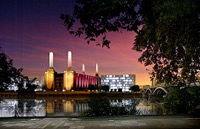Chelsea's Battersea Plan Appears to be Doomed
But football club is not giving up yet on bid for site
Chelsea Football Club's bid to buy Battersea Power Station seems to be doomed this week, after it was announced on Thursday that a joint proposal from two Malaysian companies - SP Setia and Sime Darby - had been chosen as the preferred bid.
However, the club have not given up yet on their ambition to move south of their river and build an "iconic " new stadium.
Having been selected, SP Setia and Sime Darby now have 28 days to prove everything is in place to carry out their £400 million real estate regeneration project, in a process called "due diligence".
A statement from the club says: " Chelsea Football Club has been informed that the administrators of the Battersea Power Station site have entered into an exclusive agreement with another party to carry out their due diligence.
" We will all be able to speak with more confidence about the site's future once the exclusivity period is over and the preferred bidder has been able to assimilate their risks properly and confirm the bid.
"
We are disappointed not to be selected as the preferred bidder for Battersea Power Station, as we believe we can create an iconic and architecturally significant stadium on the site in a scheme which is commercially viable and of great benefit to the Wandsworth community and London generally.
" We have been clear throughout this process that Battersea is one of a limited number of options the club is considering."
Even if the club were to be selected by the administrators however, they would still face a number of obstacles. Chelsea would require permission from newly re-elected Mayor Boris Johnson to redevelop the landmark Grade II listed power station.
However, the Mayor's chief of staff and Deputy Mayor for planning, Sir Edward Lister, has already said: " I don't think the site is suitable for Chelsea, and nor do a lot of people. It's not a goer. "
One reason for his rejection is that he claims the transport links to Battersea are not suitable for a mass influx of football fans, although Chelsea have offered to contribute towards the cost of an extension of the Northern Line to the power station.
Before moving, the club would also have to persuade Chelsea Pitch Owners, the group of fans who own the freehold at Stamford Bridge, to sell it back.
However, the club already failed in a first effort to persuade them at a meeting held on October 27 last year. In a vote held among Chelsea Pitch Owners shareholders over the purchase of the freehold, 61.6% voted yes - but approval of 75% of the shareholders was needed to pass the proposal.
Chelsea will need to repeat this vote, hoping to achieve a more positive result, if they want to move out of Stamford Bridge.
Chelsea are also facing competition from a number of other bidders for the historic site. Despite the cost, estimated to be around £300 million for the site itself and another £200 million paid as a contribution to the Northern Line Extension, ten companies are said to have made proposals to buy the site.
Renowned architect Sir Terry Farrell has also put together his own proposal for redevelopment of the site, which he hopes will attract developers. This scheme would see parts of the building demolished but retain the distinctive four white chimneys and walls and could cost less than £50 million, compared with the £5.5 billion cost of a previous proposal.
Wandsworth Council have not immediately rejected Chelsea's bid, with council leader Ravi Govindia said that the key to a successful bid was the delivery of the Northern Line Extension. However, sources at the council say they are not keen to see the club move into the borough.
June 8, 2012
